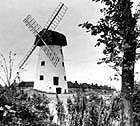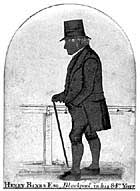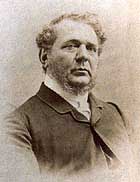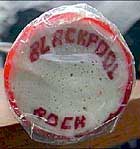

the rise and rise of the working class holiday team
[Blackpool history]
![]()
history

A westerly view of Blackpool, 1784, showing the four original taverns -- a Sears Bros engraving. Left to right: E Mr Bailey's Tavern, G Mr Forshaw's Tavern, I Mr Hudson's Tavern, K Mr Hull's Tavern, L Mr Boney's [sic] wine house
Adapted from Blackpool: History, published by Blackpool Borough Council, 1990.
The early Fylde
Before the arrival of the Romans, the Fylde -- a plain between
the rivers Wyre and Ribble and extending from the sea eastwards
to the foothills of the Pennines -- was covered in oak forests
and impassable bogs. The inhabitants were known as the Setantii or Segantii -- 'dwellers in the country of water'. The Romans built a road
that ran through Preston to a settlement outside Kirkham fort
and continued westwards, probably towards a Roman port (Portus Setantiorum) thought to have been located two miles north of Fleetwood at
the point where the Wyre discharges into the Lune Deeps.
Blackpool's early boundaries were within the township of Layton with Warbreck, part of the manor of Layton that, together with Bispham and Norbreck, formed the ancient parish of Bispham (or Biscopham) recorded in the Domesday Book of 1086. In 1416, members of the powerful Butler family were granted manorial rights over much of the Fylde coast area, including 'Le pull'. This 'pull' or 'pool' was a stream draining the mile-square Marton Mere into the sea near present-day Manchester Square.
The peat lands through which the stream ran caused the water to become discoloured -- hence the name 'Black Poole'. In 1602, entries in the Bispham parish baptismal register mention 'de Poole' and 'de blackpoole'. At that time, a collection of cobble-and-clay huts spread along the coast near the 'Pool'. However, by the end of the century, some landed gentry -- led by the Tyldesleys of Fox Hall -- had settled in the area.

Windy city
The many mills in the Fylde are responsible for its nickname:
'Windmill Land'. Lytham St Anne's is said to have the oldest windmill
in England, dating from 1190. Little Marton Mill, at the entrance
to Blackpool, was built in 1838 and remained in good working order
until 1923.
the first visitors
By the 1720s, the healthy attributes of the Irish Sea coast had
already drawn the first visitors to Blackpool, but they were forced
to sleep anywhere that would take them in. In 1735, however, a
cottage owned by Ethart a Whiteside, located where General Street
now is, was redeveloped especially for visitors. Twenty years
later, Blackpool possessed four registered ale houses. By 1780,
the 'resort' could boast an equal number of substantial hotels
catering for well-to-do patrons: Bailey's (now the Metropole),
Forshaw's (now the Clifton Arms), Hudson's (on the site of Harry
Ramsden's fish restaurant) and Hull's (on the site of Pricebusters
store). In addition, accommodation was offered at Fox Hall, Bonny's
(now the King Edward VII, Central Drive) and the Gynn as well
as in houses throughout the area.
In 1788, the Midland publisher and historian William Hutton visited Blackpool and described the town as he saw it:
The sea coast at Blackpool forms a strait [sic] line for many miles. The bank or cliff, which is clay, rises various heights, from three feet to sixty above high water mark. Although about fifty houses grace the sea-bank, it does not merit the name of a village because they are scattered to the extent of a mile. About six of these make a figure, front the sea with an aspect exactly west, and are appropriated for the reception of company: the others are the dwellings of the inhabitants, which chiefly form the background. In some of these are lodged the inferior class, whose sole motive for visiting this airy region is health.
Hutton went on to describe in some detail the recreations enjoyed by the visitors of the 1770s. The rich rode in carriages or on horseback along the sands, while poorer visitors 'find equal pleasure in using their feet'. Of the promenade -- a stretch of grass measuring 3 m (3.1 yd) by 180 m (220 yd) -- he said, 'A perpetual assemblage of company, when the weather permits, may be seen upon this elegant little walk'. There were bowling greens and facilities for archery, as well as 'a place dignified with the name of The Theatre; if that will bear the name which, during nine months in the year, is only the threshing floor of a barn'. But, of course, Blackpool's main attraction was the sea -- seabathing and the drinking of sea water were then national crazes. A bell was rung when it was time for the ladies to bathe; any gentleman found on the shore would be fined a bottle of wine.


Henry Banks
Dr John Cocker
the 'father of Blackpool'
At the turn of the 19th century, the development of the resort
came close to stagnation through the inaction of the principal
landowners. The situation was transformed by Henry Banks, often
considered to be the 'Father of Blackpool', who in 1810 bought
the Lane Ends estate, including the Lane Ends Hotel (at the bottom
of Church Street). He soon built the first holiday cottages and,
in 1837 with his son-in-law Dr John Cocker, erected Blackpool's
first assembly rooms in Victoria Terrace -- still standing at
the north-west corner of Bank Hey and Victoria streets.
coming of the railways
In the early years, travel to Blackpool involved much discomfort,
a journey from Manchester taking a day and one from Yorkshire
taking two. The situation was transformed in 1840 when the Preston
& Wyre Railway was built to serve Sir Peter Hesketh Fleetwood's
proposed elegant port and watering place at the mouth of the river.
However, the development of Fleetwood soon ground to a halt through
lack of capital, and the railway -- then on the verge of collapse
-- was only saved by cheap excursion trains from the industrial
north, many of the trippers travelling on to Blackpool from Poulton
station by horsebus or wagonette. When the railway reached Talbot
Road station on 29 April 1846, the resort was scarcely prepared
for the thousands of visitors from Lancashire and Yorkshire who
could now reach it with comparative ease.
When, after much previous local opposition, 'Layton with Warbrick' [sic] was constituted a local Board of Health district on 23 October 1851, the town consisted of little more than 420 dwellings, housing some 2,500 individuals. Gas lighting came in 1852 (initially provided by a private company), but piped water did not arrive until 1864. The first stretch of the Promenade proper -- a pathway from Talbot Square to Church Street, lined with a post-and-rail fence -- was opened in 1836.
the foundation of the resort
The first place in Blackpool dedicated solely to amusement was
Uncle Tom's Cabin, perched on the crumbling cliffs to the north
of the town. Commercialised in about 1860, the original building
was lost to the sea in 1907. The North Pier, designed by Eugenius
Birch and built of cast iron on screwed piles, opened on 23 May
1863. It soon became an exclusive promenade for 'quality' visitors,
and is now a listed building. Four years later, the Prince of
Wales Arcade (now the site of the Tower) opened, and a year after
that, the Theatre Royal (now Yates' Wine Lodge) and the South Jetty were added to the list of attractions. The
latter, now the Central Pier, was not well patronised until 1870
when Robert Bickerstaffe introduced open-air dancing for the 'working
classes', who could also, in the same year, walk down the Promenade
from South Shore to Claremont Park (immediately north of the Metropole).
In 1872, the outdoor pleasure gardens at Raikes Hall (built in c. 1760 and still extant as a pub) were opened half a mile up Church Street from the Promenade. While they soon gained fame for dances and firework displays, they were never a financial success, and the land was sold off for building in 1901. Also in 1872, Dr W H Cocker bought the Prince of Wales Arcade and turned it into a private aquarium; three years later, it was opened to the public, and it still exists within the Tower buildings. A new Prince of Wales Arcade was built on an adjoining site and later enlarged by a theatre (1877) and baths (1881).
One thing that the resort still lacked was substantial indoor facilities. This problem was solved on 11 July 1878 with the opening of the Winter Gardens, which contained a promenade and pavilion. The prospect of this new attraction forced its rival, the North Pier Company, to build its Indian Pavilion at the seaward end of the pier in 1877.
The existing rail link could not cater for all the trippers now wishing to visit Blackpool. Therefore the single-line coastal railway, opened in 1863 to run between Lytham and Blackpool Central, was rebuilt as a double track and linked with the Kirkham-to-Lytham line. Central station (now Coral Island) soon became the town's principal terminus.

Dr William Henry Cocker
a borough and electric light
The town -- having almost doubled in population in the previous
decade -- was granted a Charter of Incorporation as a borough
on 21 January 1876. Dr William Henry Cocker -- son of Dr John
Cocker and grandson of Henry Banks -- became the first mayor.
Although 1877 saw the opening of the Borough Theatre (later Feldman's and The Queen's Theatre), the resort soon found itself in the middle of a financial downturn that threatened the future of the whole town. The council, casting about for a way out of this depression, decided to hold a grand fete and carnival on the beach between the two piers to publicise the installation of the world's first electric arc street lighting. This event featured a 'naval attack on Blackpool' that was watched by up to 100,000 people on the Promenade and piers and in sea-going craft of various sorts. Blackpool was now catering for the working classes of Lancashire and Yorkshire, rather than for the gentry, who had repaired to Lytham St Anne's.
The increasing popularity of the resort forced the council to examine various transport systems to supplement the town's horsebuses and landaus. An electric railway -- a novelty set up in the grounds of the Winter Gardens -- led the council to Michael Holdroyd Smith and his conduit system of electric tramway operation. The world's first permanent electric street tramway -- running from Cocker Street to South Shore -- opened on 29 September 1885.
the entertainment boom
It is estimated that, in the 1890s, Blackpool's 7,000 dwellings
could accommodate 250,000 holiday-makers. That period also saw
the development of many of the resort's most famous attractions.
In 1893, the Victoria Pier (now South Pier) opened, and the following
year, impressario Thomas Sergenson treated Blackpudlians and visitors
to his Grand Theatre in Church Street.
In 1889, an opera house was built in the Winter Gardens complex, and two years later, a start was made on the 'Eiffel Tower'. Dr Cocker's aquarium was incorporated into the buildings, which also included a circus and a ballroom. The tower itself, 1581 m (518 ft 9 in) high, was opened at Whitsuntide 1894.
With the triumph of the Tower, the Winter Gardens looked for a new feature as a counter-attraction. In 1896, the 'Gigantic Wheel' was erected at the corner of Adelaide and Coronation streets. However, the 65 m (220 ft) high wheel, with 30 carriages each holding over 30 passengers, was never a great success; it made its last circular trip on 20 October 1928 and was demolished shortly afterwards.
The existing theatres were joined by, in 1895, the Empire (later the Hippodrome and now the ABC) and, four years later, the Alhambra, which was built on the site of the Lane Ends Hotel and Prince of Wales theatre. The Alhambra, however, proved to be a financial disaster and, taken over by the Tower Company, it reopened as the Palace in 1904.
The Golden Mile was created when, in 1897, the Corporation banned stalls from the beach and the traders moved into the gardens of houses on the Promenade. A new length of the latter -- between Carleton Terrace (Cocker Street) and the Gynn -- was completed in 1899 at a cost of £144, 716. Construction of the present Promenade between the North and South Piers was carried out between 1902 and 1905, and involved reclaiming about 22 acres from the sea.
into the 20th century
The turn of the century saw a transformation in the town's transport
system. In September 1892, the trams -- which had continued to
be restricted to the Promenade -- were taken over by the Corporation
and, three years later, were extended along Lytham Road and, later
still, were connected to the system operated by the Blackpool,
St Anne's & Lytham Tramway Company Ltd. The private Blackpool
& Fleetwood Tramroad -- running eight miles between Talbot Road
station and the Fleetwood ferry - was opened in July 1898 and
soon showed the advantage of the overhead system of power collection.
Within a year, this type was adopted on the existing Corporation
routes and then on the extensions to the Gynn (1900), around Marton
(Church Street, Whitegate Drive and Waterloo Road; 1901) and to
Layton (1902).
The Corporation took over the Fleetwood Tramroad in 1920 and, six years later, built the extension to Starr Gate. In 1961, the route along Lytham Road was replaced by bus services, as was the route around Marton the following year, and the link between North station and the Gynn along Dickson Road was closed in 1963. This meant that, for three decades, the Promenade route was the only commercial electric tramway in the country - until it was joined by the trams in Manchester in 1993.
Blackpool was constituted a county borough on 1 October 1904, a dignity it retained until the reorganisation of local government on 1 April 1974.
At about the same time as the Promenade between the piers was established, the Pleasure Beach had its beginnings. In the sand dunes beyond South Shore, for many years the home of gypsies and fairground artistes, a number of rides were erected. One of the very first was Sir Hiram Maxim's Captive Flying Machine -- started in 1904 and still existing today, although in somewhat different guise -- and gradually more came to fill the present 40-acre fun park. As a consequence, rail traffic to the resort became increasingly heavy, so much so that the existing stations at Talbot Road and Central had to be rebuilt in, respectively, 1898 and 1900, and a new direct route opened from Kirkham to South Shore in 1903.
illuminations and war
The first illuminated trams were part of Blackpool's celebrations
for Queen Victoria's Jubilee in 1897. But the Illuminations proper
could be said to have begun on 2 May 1912, when a static light
display greeted Princess Louise, who had come to Blackpool to
open the Princess Parade. The display was well received and was
revived in late summer; an even more ambitious one was produced
the next year, a season that broke all records.
However, the outbreak of World War I in 1914 interrupted the Lights and they were not seen again until 1925. The years of conflict saw 14,000 troops billeted in the town, and a major convalescent hospital was built on land now part of the airport at Squires Gate. However, despite the conflict, additional visitors were attracted to Blackpool, since many south and east coast resorts were closed to them.
The interwar period was one of consolidation with many civic developments, including: Promenade extensions at Bispham, Norbreck and South Shore; the open-air baths; Stanley Park and its nearby aerodrome; the technical college; and the Talbot Road bus station and carpark. This last was an indication of the growing importance of road transport in Blackpool, although a comprehensive rebuilding of the Central railway station planned for 1939 was only halted by the war. In the private sector, the Tower Company and the Winter Gardens merged in 1928, and during the decade that followed, a new opera house and Odeon cinema were constructed as well as a number of features at the Pleasure Beach.
At the start of World War II, Blackpool received 37,500 evacuees and 1,700 civil servants, but most of the former went home within a few months. They were replaced by the first of the 769,673 airmen who were eventually sent to the town and given their initial training at the Winter Gardens, heart of RAF Blackpool; evening entertainments carried on as usual. Wellington bombers were assembled in a new Vickers-Armstrong factory at Squires Gate; after the war, this was used for the manufacture of pre-fabricated houses and Hunter jets, and it is now a trading estate. The wartime aircraft construction at Squires Gate led to the government developing the existing airport; in 1962, this was purchased by the Corporation to replace the municipal aerodrome east of Stanley Park, which by 1939 had ceased to serve a useful role.
The Illuminations were again switched off between 1939 and 1948. However, in 1949, when fuel restrictions were relaxed, they were revived and are now one of Blackpool's great attractions.

Blackpool today
In 1955, the boundaries of the borough were extended to include
a small part of the urban district of Poulton-le-Fylde. As a result
of this and earlier extensions, the borough's area has increased
from 2,358 acres in 1876 to today's total of 8,650 acres [3.500
hectares] of land and 2,068 acres [837 hectares] of foreshore
and tidal water. The population rose slowly over the years --
from 473 in 1801 to 3,707 in 1861, reaching 47,348 by 1901 and
101,553 by 1931 -- and has now steadied at around 145,000. The
seaside remains an attraction for people of retirement age, who
comprise 27.8% of Blackpool's population, compared with 18.9%
in Britain as a whole.
Blackpool's tourist industry is thought to employ about 12,500 people. A national survey in 1989 found that 4,190,000 holiday-makers stayed in the resort and a further 12,590,000 came on day or evening trips, all of whom are believed to have spent over £445 million in the town. Over the past 20 years, the pattern of holidays has changed. There is now an increasing emphasis on self-catering accommodation -- which now forms 25.5% of Blackpool's stock of hotels, guesthouses and holiday flat premises -- as well as on day trips and short breaks throughout an extended season.
While the traditional areas of Lancashire, Yorkshire and Scotland still provide the bulk of the visitors, strenuous efforts are now being made to attract foreign ones. The variety of accommodation available makes the town particularly suitable for conferences, trade fairs and festivals.
In 1980, Blackpool's first indoor shopping centre -- Hounds Hill -- opened on a three-acre site next to the entertainment area close to the Promenade. The town can now offer visitors over 1 million sq f t [9.29 hectares] of shopping space. The Corporation has actively pursued policies of pedestrianisation in the shopping streets, and now most of the principal ones are traffic free.
After World War II, the shift from rail to road continued, but even more markedly than before. Central station closed in 1964, giving space for the development of the Coral Island entertainment centre and courts complex, as well as releasing extensive areas for car and coach parking. In 1975, the M55 opened, allowing swift vehicle passage from the M6 to the borough boundary. The rebuilt Blackpool North station is now the principal railway terminus, with Blackpool South returning to the branchline status it had in early days. The new Pleasure Beach railway station opened in April 1987.
While it is likely that catering for visitors in terms of accommodation and entertainment will continue to dominate Blackpool's economy, the town is growing as a regional shopping centre, and is actively promoting itself as a place for industrial expansion.




